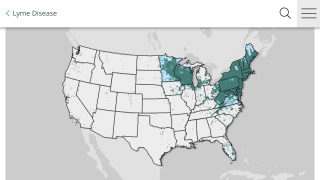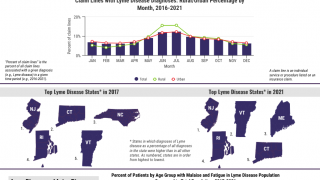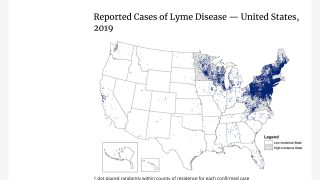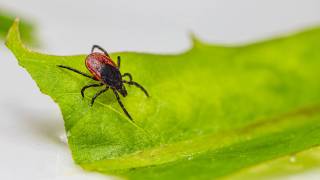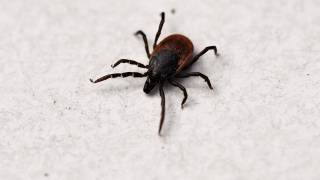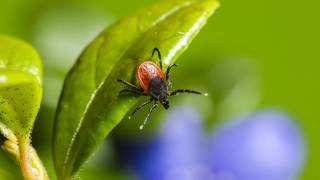Lyme Disease Carrying Ticks Are Outside This Summer

Before taking a walk in the country woods this summer, health experts suggest protecting yourself from unwanted tick-borne diseases, such as Lyme disease.
While Lyme disease is the most often tick-related disease discussed, various tick species carry and transmit a collection of other pathogens.
In fact, the number of tick-borne disease cases is on the rise in the United States, says the Centers for Disease Control and Prevention (CDC).
Moreover, the geo-range where various species of ticks live in North America is expanding.
CDC research continues to disclose new pathogens that live in ticks, such as these diseases:
- Anaplasmosis is transmitted to humans by tick bites primarily from the black-legged tick (Ixodes scapularis) in the northeastern and upper midwestern U.S. and the western black-legged tick (Ixodes pacificus) along the Pacific coast.
- Babesiosis is caused by microscopic parasites that infect red blood cells. Most human cases of babesiosis in the U.S. are caused by Babesia microti. Babesia microti is transmitted by the black-legged tick (Ixodes scapularis) and is found primarily in the northeast and upper midwest.
- Borrelia mayonii infection has recently been described as a cause of illness in the upper midwestern United States. It has been found in black-legged ticks (Ixodes scapularis) in Minnesota and Wisconsin. Borrelia mayonii is a new species and is the only species besides B. burgdorferi known to cause Lyme disease in North America.
- Borrelia miyamotoi infection has recently been described as a cause of illness in the U.S. It is transmitted by the black-legged tick (Ixodes scapularis) and has a range similar to that of Lyme disease.
- Bourbon virus infection has been identified in a limited number of patients in the Midwest and the southern United States. At this time, we do not know if the virus might be found in other areas of the United States.
- Colorado tick fever is caused by a virus transmitted by the Rocky Mountain wood tick (Dermacentor andersoni). It occurs in the Rocky Mountain states at elevations of 4,000 to 10,500 feet.
- Ehrlichiosis is transmitted to humans by the lone star tick (Ambylomma americanum), found primarily in the southcentral and eastern U.S.
- Heartland virus cases have been identified in the Midwestern and southern United States. Studies suggest that Lone Star ticks can transmit the virus. It is unknown if the virus may be found in other areas of the U.S.
- Lyme disease is transmitted by the black-legged tick (Ixodes scapularis) in the northeastern U.S. and upper midwestern U.S. and the western black-legged tick (Ixodes pacificus) along the Pacific coast.
- Powassan disease is transmitted by the black-legged tick (Ixodes scapularis) and the groundhog tick (Ixodes cookei). Cases have been reported primarily from northeastern states and the Great Lakes region.
- Rickettsia parkeri rickettsiosis is transmitted to humans by the Gulf Coast tick (Amblyomma maculatum).
- Rocky Mountain spotted fever (RMSF) is transmitted by the American dog tick (Dermacentor variabilis), Rocky Mountain wood tick (Dermacentor andersoni), and the brown dog tick (Rhipicephalus sangunineus) in the U.S. The brown dog tick and other tick species are associated with RMSF in Central and South America.
- STARI (Southern tick-associated rash illness) is transmitted via bites from the lone star tick (Ambylomma americanum), found in the southeastern and eastern U.S.
- Tickborne relapsing fever (TBRF) is transmitted to humans through the bite of infected soft ticks. TBRF has been reported in 15 states: Arizona, California, Colorado, Idaho, Kansas, Montana, Nevada, New Mexico, Ohio, Oklahoma, Oregon, Texas, Utah, Washington, and Wyoming and is associated with sleeping in rustic cabins and vacation homes.
- Tularemia is transmitted to humans by the dog tick (Dermacentor variabilis), the wood tick (Dermacentor andersoni), and the lone star tick (Amblyomma americanum). Tularemia occurs throughout the U.S.
- 364D rickettsiosis (Rickettsia phillipi, proposed) is transmitted to humans by the Pacific Coast tick (Dermacentor occidentalis ticks). This is a new disease that has been found in California.
In related news, the Infectious Diseases Society of America, American Academy of Neurology, and American Academy of Rheumatology announced in June 2019 that they are now accepting public comments on draft guidelines for the prevention, diagnosis, and treatment of Lyme disease, through August 10, 2019.
Those wishing to provide feedback can view the draft guidelines and submit their comments on the IDSA website.
“The development of a Lyme disease vaccine would be a significant milestone in preventing an illness that can have severe lifelong symptoms. Even after this development, people will still need to protect themselves against all tickborne illnesses while participating in outdoor activities,” said Holly Hawbaker, PharmD Candidate, Intern for Brookshires Grocery Company.
“Ways to do this include limiting exposed skin, using bug repellants, and always checking yourself and any pets for ticks after being outside, especially when in tall grass or wooded areas”, continued Hawbaker.
Recently, a French biotech company announced the initiation of the second Phase 2 clinical trial for the development of its Lyme disease preventive vaccine candidate VLA15.
This is important news since the medical need for a Lyme disease preventive vaccine is steadily increasing. According to the CDC, approximately 300,000 Americans are diagnosed with Lyme disease each year, with at least a further 200,000 cases in Europe.
>>> Fast Lyme Disease Testing <<<
The objectives for this VLA15-202 clinical study are to determine the optimal dosage level and vaccination schedule for use in Phase 3 pivotal field efficacy studies, based on immunogenicity and safety data.
The Phase 2 Clinical Study VLA15-202 is a randomized, observer-blind, placebo-controlled study of 250 subjects conducted at trial sites in the US. This study’s results are expected in 2020.
Valneva’s VLA15 vaccine was granted Fast Track designation by the U.S. Food and Drug Administration in July 2017.
Our Trust Standards: Medical Advisory Committee



